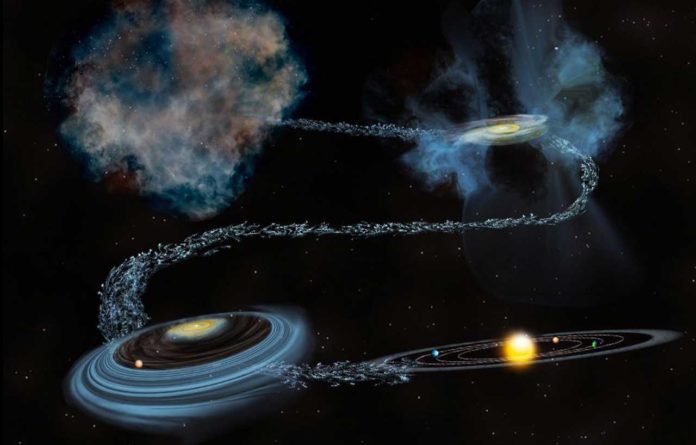At the beginning of the universe, 13.7 billion years ago, heavy elements like iron and silver did not exist. They formed with nuclear reactions called nucleosynthesis that combined atoms.
Scientists believe that some of the heaviest elements like iodine, gold, platinum, uranium, plutonium, and curium were formed during a specific type of nucleosynthesis called the rapid neutron capture process, or r-process.
However, which astronomical events can produce the heaviest elements, remains obscure.
In a new study by a team of international scientists, scientists went back to forming the solar system 4.6 billion years ago to gain new insights into the heaviest elements’ cosmic origin on the periodic table.
The study was conducted in the International Research Network for Nuclear Astrophysics (IReNA) and the Joint Institute for Nuclear Astrophysics – Center for the Evolution of the Elements (JINA-CEE).
In today’s date, scientists believe that the r-process can occur during violent collisions between two neutron stars, between a neutron star and a black hole, or during rare explosions following the death of massive stars. Such highly energetic events occur very rarely in the universe.
During such events, neutrons go into the nucleus of atoms, then converted into protons. Since the periodic table elements are defined by the number of protons in their nucleus, the r-process builds up heavier nuclei as more neutrons are captured.
Sometimes, the r-process also produces radioactive nuclei that take millions of years to decay into stable nuclei. Such nuclei are then going into a solid-state that eventually fell on the earth’s surface as meteorites.
Inside these meteorites, the radioactive decay generated an excess of stable nuclei. Today, this excess can be measured in laboratories to figure out the amount of iodine-129 and curium-247 present in the solar system just before its formation.
Both r-process nuclei are so special as they have a common property- decaying at the same rate.
Benoit Côté from the Konkoly Observatory, the leader of the study, said, “This is an amazing coincidence, particularly given that these nuclei are two of only five radioactive r-process nuclei that can be measured in meteorites.”
“With the iodine-129 to curium-247 ratio being frozen in time, like a prehistoric fossil, we can have a direct look into the last wave of heavy element production that built up the composition of the solar system, and everything within it.”
Scientists calculated the iodine-129 to curium-247 ratios synthesized by collisions between neutron stars and black holes. They wanted to determine the right set of conditions that reproduce the composition of meteorites. They concluded that the amount of neutrons available during the last r-process event before the solar system’s birth could not be too high.
Too much curium would have been created relative to iodine. It means that very neutron-rich sources, such as the matter ripped off a neutron star’s surface during a collision, likely did not play an important role.
Then, how this r-process was made?
Scientists have offered a new and insightful information on this. Although, they could not pinpoint the nature of the cosmic object that created them because of nucleosynthesis models.
The models rely on uncertain nuclear properties. It is also unclear how to link neutron availability to specific astronomical objects such as massive star explosions and colliding neutron stars.
Nicole Vassh from the University of Notre Dame, coauthor of the study, said, “But the ability of the iodine-129 to curium-247 ratio to peer more directly into the fundamental nature of heavy element nucleosynthesis is an exciting prospect for the future.”
With this new diagnostic tool, advances in the fidelity of astrophysical simulations and the understanding of nuclear properties could reveal which astronomical objects created the heaviest elements of the solar system.
Côté said, “Studies like this are only possible when you bring together a multidisciplinary team, where each collaborator contributes to a distinct piece of the puzzle. The JINA-CEE 2019 Frontiers meeting provided the ideal environment to formalize the collaboration that led to the current result.”
Journal Reference:
- Benoit Côté et al. 129I and 247Cm in meteorites constrain the last astrophysical source of solar r-process elements, Science (2021). DOI: 10.1126/science.aba1111
